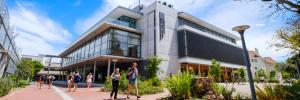
“Living laboratory" paves the way for SU to become smart campus
By using the Facilities Management Division as a living laboratory, future-fit systems and processes have been put in place since 2015 to turn Stellenbosch University (SU) into a smart campus.
According to Nicolette van den Eijkel, Facilities Management chief director, one of their strategic objectives up until 2025 is to move to a technology-enhanced campus through a process of digitalisation. Ultimately, this will enable data-led decision making to help solve problems and provide solutions for the future.
The initiative is largely driven by SU's commitment to achieve net-zero carbon status – producing and removing an equal amount of carbon emissions. By 2025, SU's Environmental Sustainability Plan seeks to reduce total consumption of fossil fuels by 50%, and to increase energy procured from clean, renewable sources to 20%, using 2019 as baseline. This requires renewable-energy, energy-efficiency and energy conservation interventions.
Smart metering and performance certificate
“We can only manage our utilities if we measure them properly," says Nadeem Gafieldien, Property Services director at Facilities Management. “That is why we've been working hard to put digital systems and infrastructure in place to measure our utilities, such as water and electricity. Our smart metering systems provide us with valuable usage data, enabling us to make effective decisions and respond to problems as and when they happen."
Gafieldien says they have been installing smart metering systems at most of the buildings on SU's five campuses, and have embarked on various projects. These have already had a significant impact on energy and water consumption and waste management at the University. “Our smart metering systems provide us with the agility to react fast and proactively plan for the future. It also enables us to verify our usage in terms of checking it against our billing information. This has already resulted in large cost savings."
Moreover, on 18 March 2021, SU's Admin B building became the first building of its kind in the country to receive an energy performance certificate. Another 50 SU buildings will be certified within the next eight months.
Data integration
Recently, Facilities Management also joined forces with Prof Anton Basson and his research team at the Department of Mechanical and Mechatronic Engineering to develop a system that can integrate all the different utilities data sources. “In our research, we look for ways to deal with information in complex systems – systems comprising many different components and interactions. As the University's utilities system is dynamic, data changes as the system evolves," says Basson. “There are a number of commercial systems available, but we have decided to develop our own, unique, integrated system to support Facilities Management's decision making and reporting."
Their approach is based on the idea of using Digital Twins and Microservices to combine data from existing systems. This will enable early detection of anomalies (such as water leaks), expedited monitoring and reporting (of, for instance, electricity use and carbon footprint), the recording of actual usage patterns (for example lecture room occupancy) and other data-led decision making. “The idea is to build a basic framework, and then add more modules to expand the system's capabilities," Basson explains, adding that the system can grow indefinitely as needs increase and new data sources are included.
Dr Anro Redelinghuys has built the basic architecture for the software and is currently working on implementing the system, with the first commercial release nearing completion. “Eventually, the system will provide different users with different dashboards of actual utility information, which will enable efficient decision making," says Basson.
Becoming a sustainable university
In the meantime, Facilities Management's sustainability team is hard at work to switch SU's processes and systems to more sustainable energy sources and reduce the impact on the environment, says Gafieldien. Efforts include creating SU's own recycling plant, installing photovoltaic panels on the roofs of campus buildings, consolidating and reducing air conditioning systems and generators, and installing greywater systems at residences and faculty buildings. All of these projects have resulted in further cost savings and are contributing to the institution's sustainability goals.
“We have even 'digitised' our trees to measure their water consumption," Gafieldien says smilingly. “In some cases, this has pointed to a need to replace some trees with water-wise endemic and indigenous ones, which we have since done."
* Click here to read more articles featured in Matieland.
